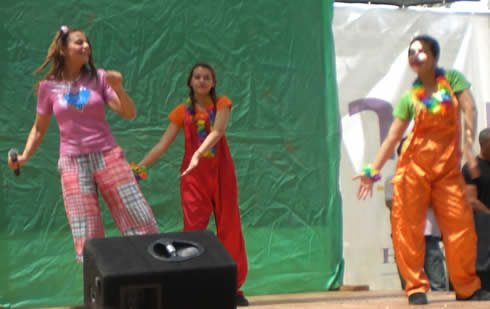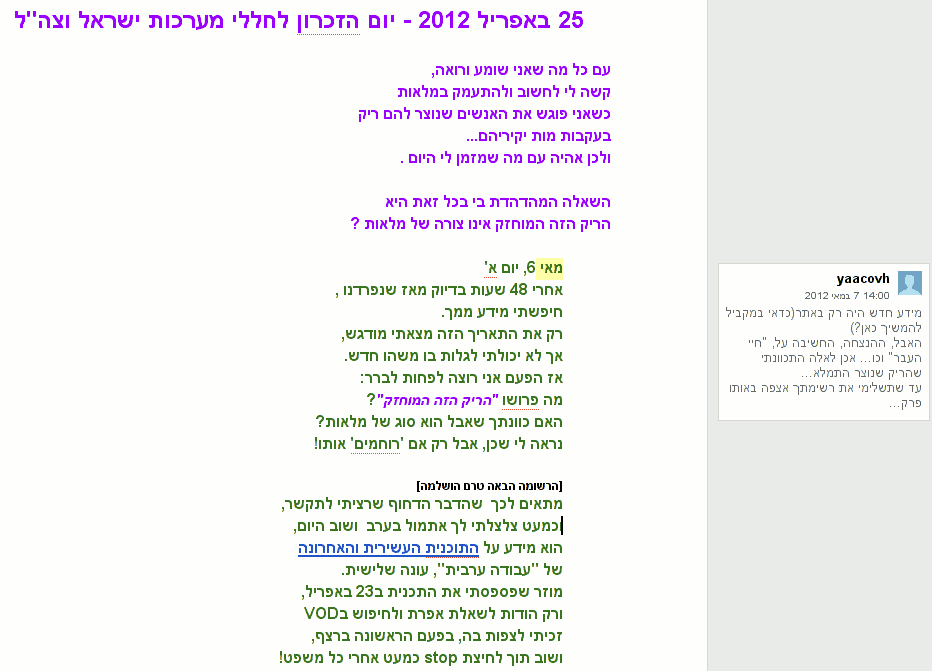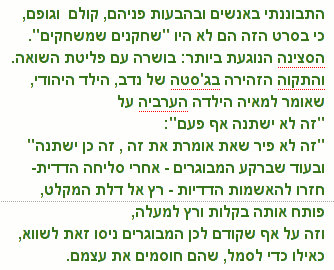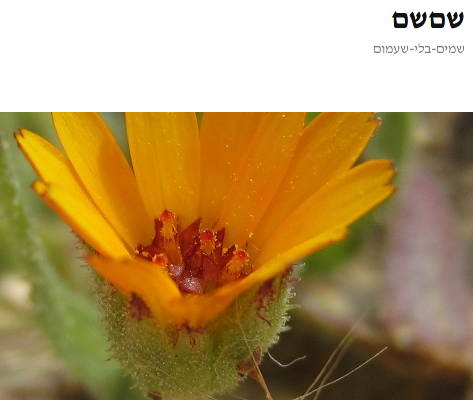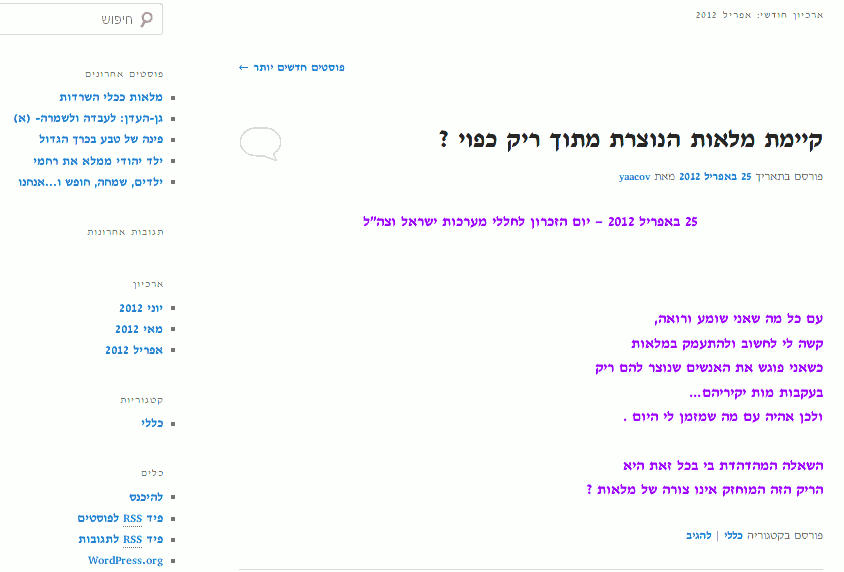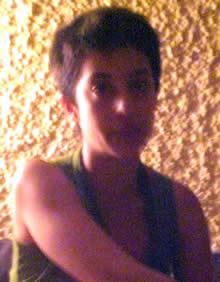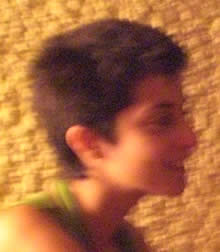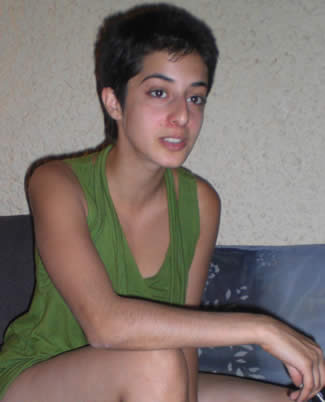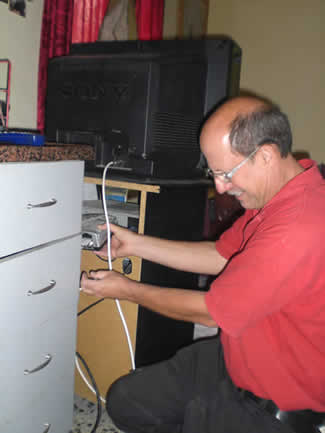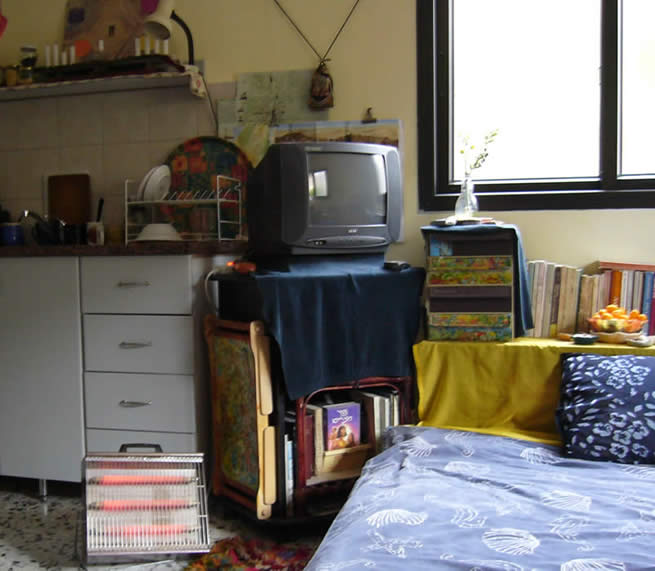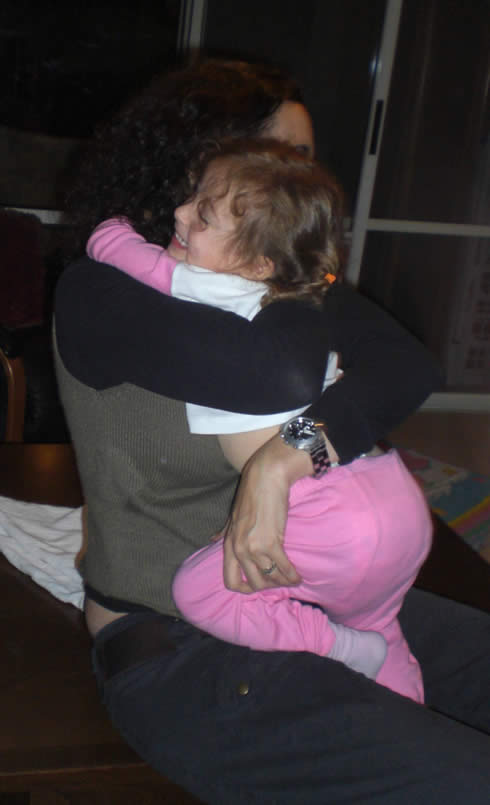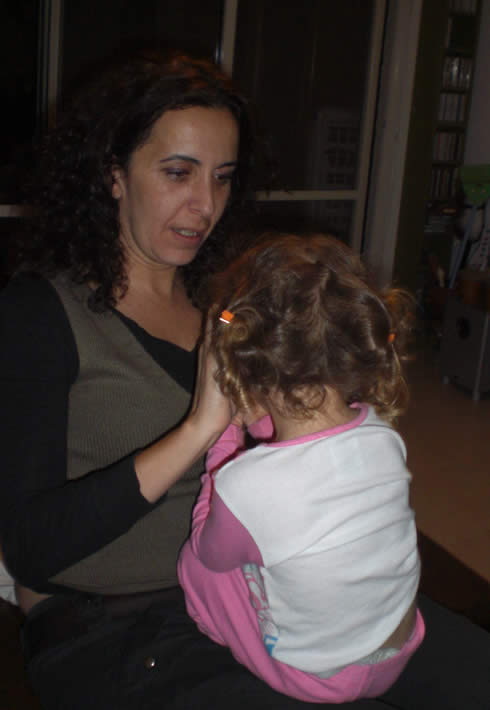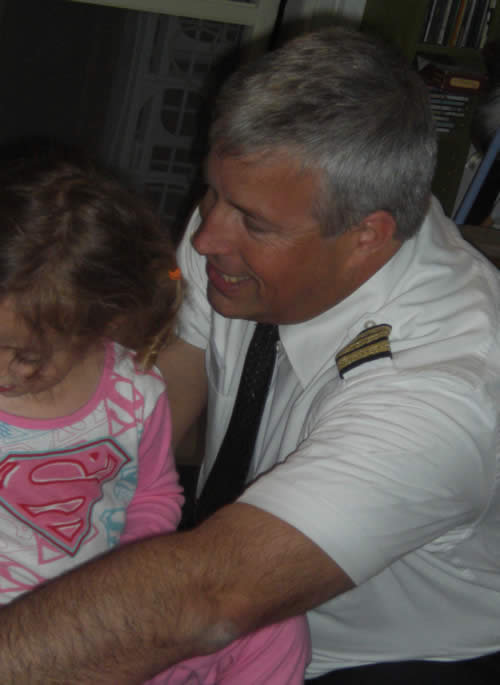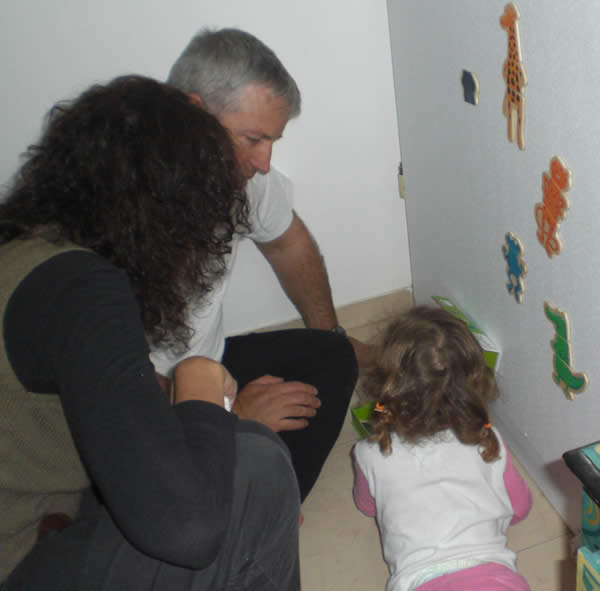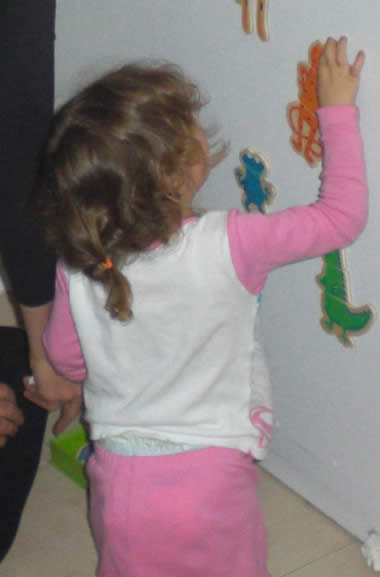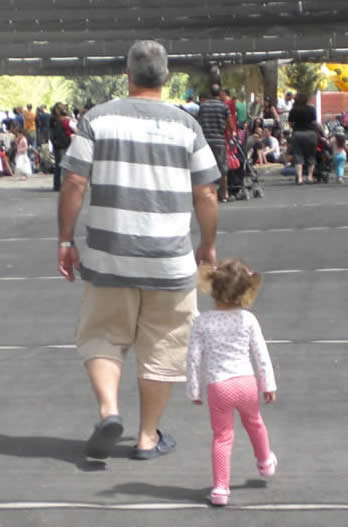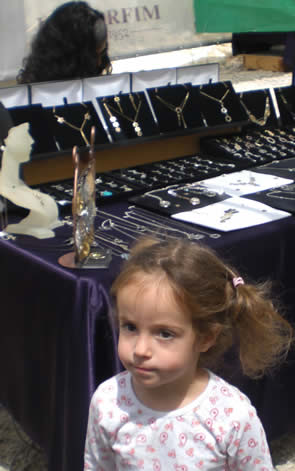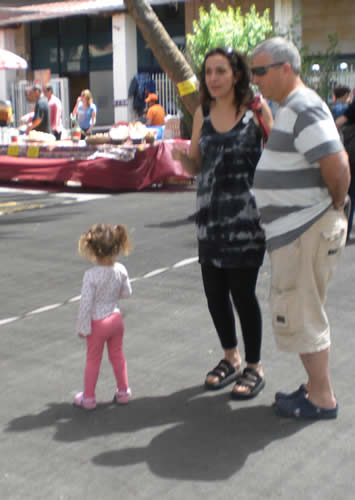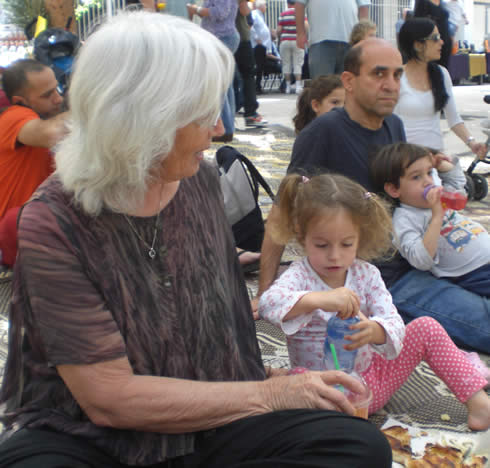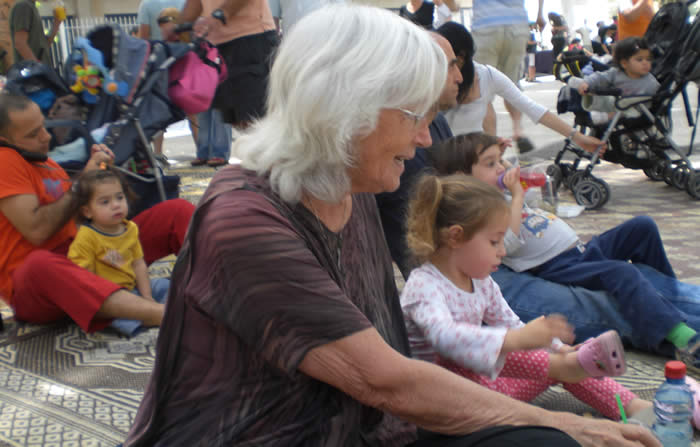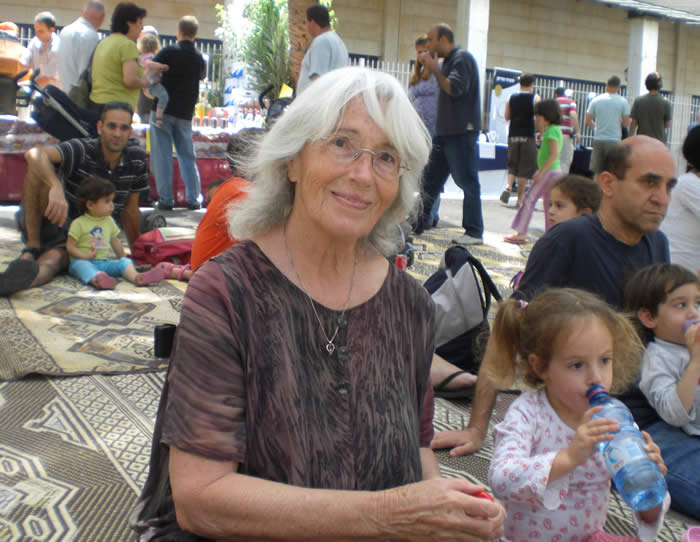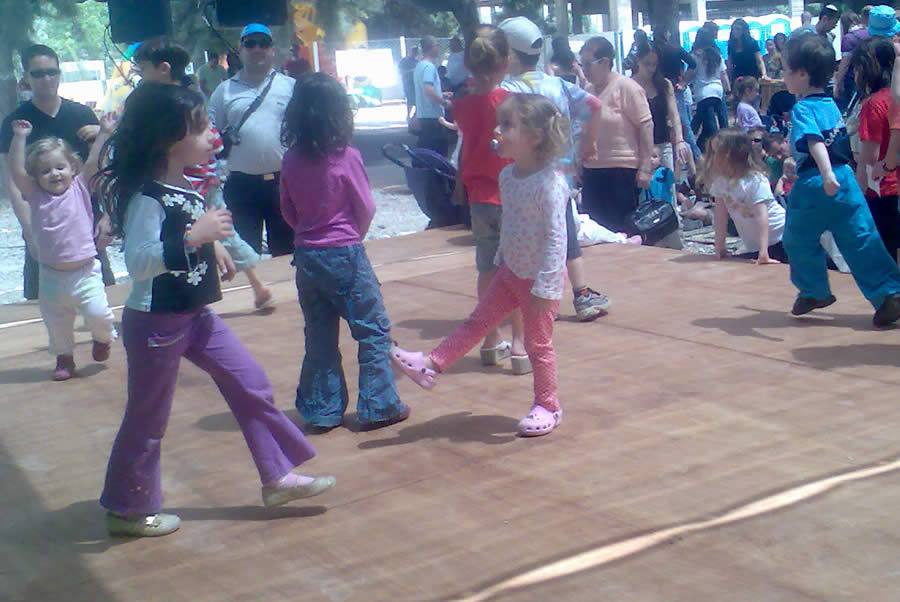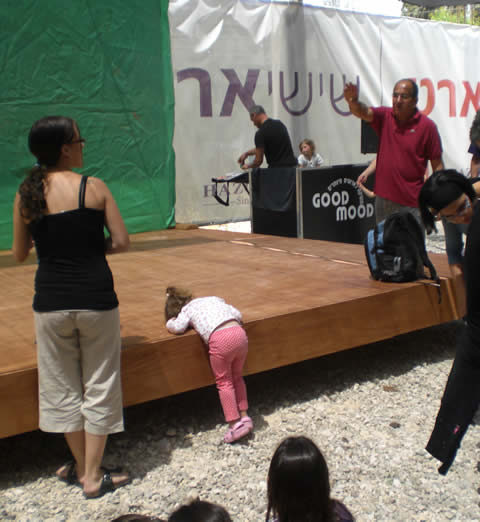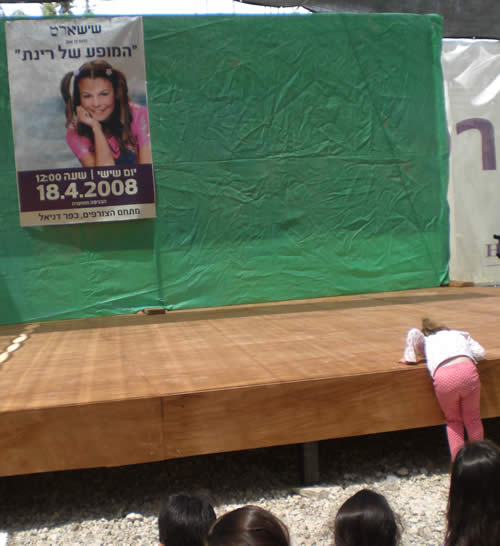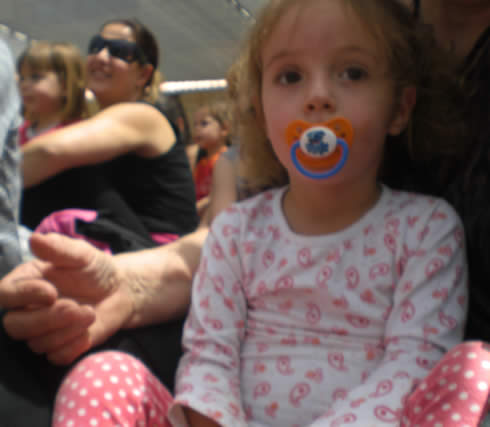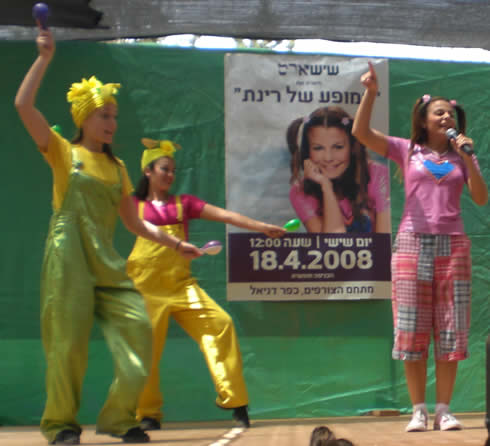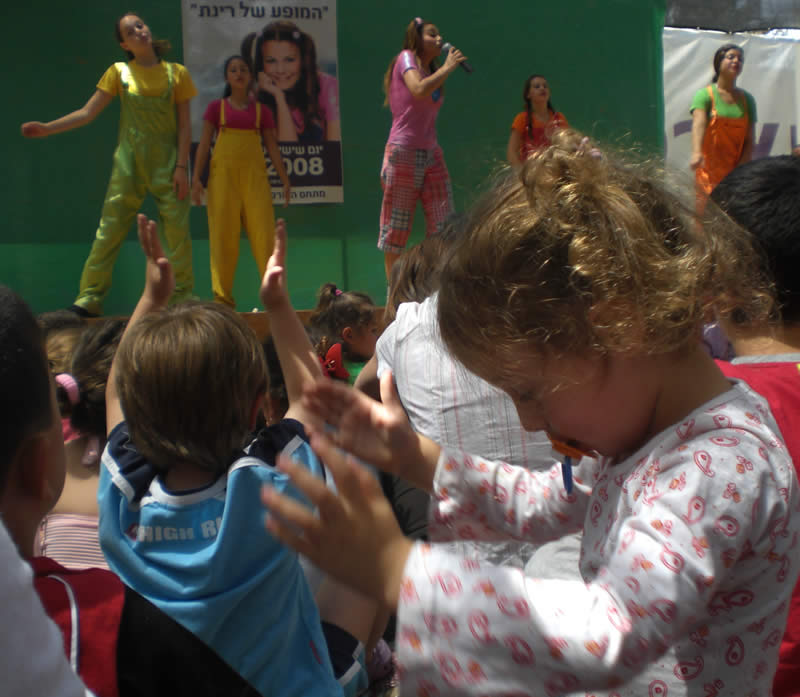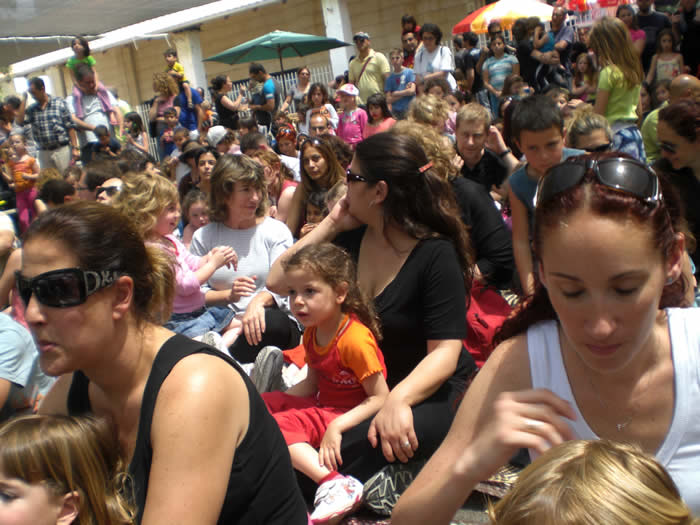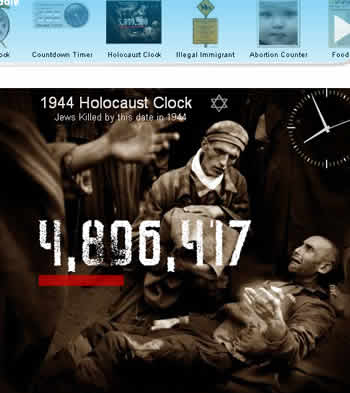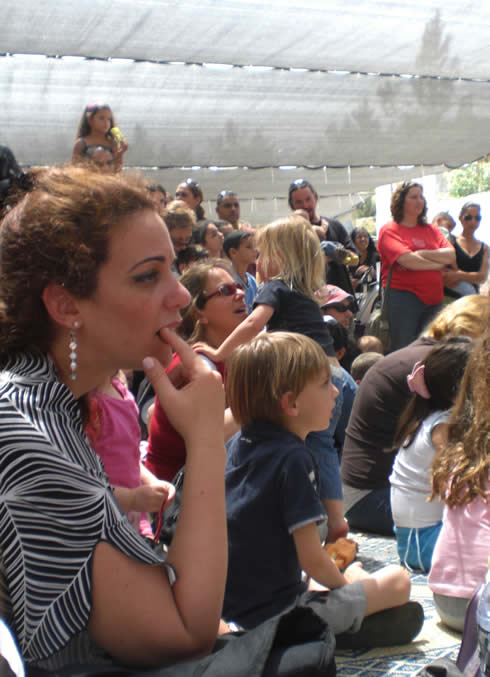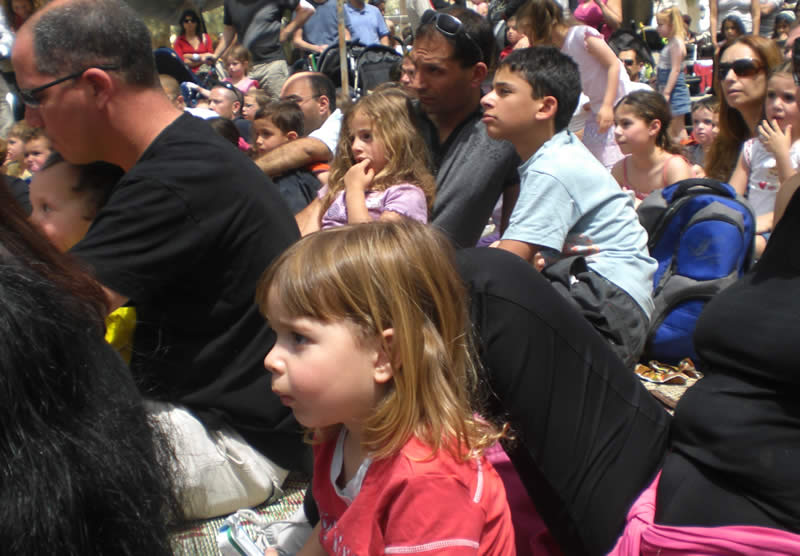|
Gabriele Dietrich
is an expert in Social Analysis research
at the Tamil-Nadu
Theological Seminary [TTS]
at Madurai, Tamil-Nadu, South India
In
Wina India on the net (Women's
Institute for New Awakening
there is a lengthy
list of Gabriele's writing from 1970 till 2003
in German, Dutch and English
and
there is an interview with Gabriele (conducted in Febr. 2004),
in a collection of articles in honor
of her, called
Waging Peace
[Rachel: These articles seem to be interesting and relevant
for me,
but since I must balance
the time I dedicate to input , reading and learning,
and the time I give to output - my own healing and creating,
it is not my preference to read them.
It was strenuous to read and understand what I quoted here.
I again feel this growing powerlessness and frustration:
Where is the balance between
what people want to give and can give,
and what people can take in and receive?
It's another aspect of the universal Cain-tragedy!
It's also the main reason, why neither my books
"Solidarity
with the sufferers in Israel", in Hebrew and in German"
"Rosenzweig, Franz,
Briefe & Tagebuecher, hrsg. von Rachel Rosenzweig, Nijhoff,
Amsterdam"
"Rosenzweig, Franz.
Arbeitspapiere zur Verdeutschung der Schrift. hrsg von Rachel
Bat-Adam. M. Nijhoff", both books mentioned in "Solidarity..."
on my website,
The second book, much more
than an "edition", is mentioned on other sites correctly
!!!! -only in Jewish
Biblical Interpretation and Methodology
- as one of many books -
nor my website are read, as far as I know, not even by Gabriele!]
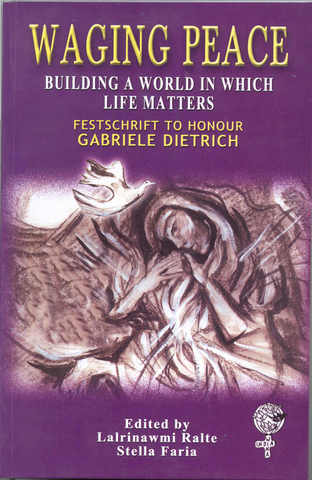
Interviewer: What did it mean to belong
to the first generation after fascism and the holocaust?
GD It took me some time to comprehend about fascism. We were
busy surviving the devastation and the scarcities of the post-war
years, trouping to the soup-kitchen run by the Swedes to escape
starvation and things like that. Also the hassle of occupation
armies, as Berlin was partitioned by the ‘allies’.
I remember food queues, the boots of soldiers, tales of rape.
It dawned upon me that the occupation was some kind of a retribution
for the conquests of Hitler’s army, in which my own father
had served as a soldier. He had never been in the fascist party.
But since he worked in the administration and was eager not
to lose his job, he was in the SA, a fascism mass organization.
His mother was widowed and his brother died in the war. He was
a run of the mill opportunist. He had to be de-nazified. He
said he never killed anybody. My mother said she never knew
about the concentration camps. In school, we were shown films,
mostly documentaries, on the Weimar Republic, the Third Reich
and the concentration camps. It became very difficult to live
with what we saw and to accept that “nobody had known”.
It implanted in me a tremendous need to live with open eyes
and to know and remember and be Accountable for a collective
history, even though I was born at a point when it all collapsed.
There was this urge of “never again”. No more war.
Never again fascism, genocide.
At the same time of course I grew up at the center of the
cold war. I lived in West-Berlin which from 1948 onwards was
this island in the “red sea” of the German Democratic
Republic, a socialist state. West Berlin was a symbol of the
so-called “free-world”. We were on the road much
of the time “to defend democracy”. Every summer
there were threats of a new blockade. People hoarded food “just
in case”. This situation ended only when the wall was
built in1961.
When I was ten years old, I witnessed two important events.
One was the uprising of the 17th of June, the uprising of the
German Democratic Republic workers against the workers’
state, because the state had raised the norms of output and
unions were under strict control. The uprising was crushed by
Soviet tanks. The other thing I remember was the death of Stalin.
I vividly remember the newsreels. I felt enormous relief at
his death because of the Soviet tanks and the show trials against
communists.
About two years later, I read the diary of Anne Frank, the
Jewish teenager who had been hiding in Amsterdam and later died
of typhoid in the concentration camp of Bergen Belsen. I felt
like I myself had lived in hiding in that house in the Prinsengracht.
It was at that time that I first grasped the enormity of fascism
and the need to live down racism.
What was your relationship to the church?
GD There was no relationship to any church in my family. I
never saw a church from the inside, though my family had me
baptized. My maternal grandmother, who was a widow and refugee
of World War I, had given up on faith as a result of the hardships
of her life. I knew many people who felt that “if God
existed, he would not have allowed all these things to happen”.
My mother said it was good for people if they could believe
in God. But it was not clear to me what her own position was.
Nobody ever prayed or read the bible.
I grew up in pre-television time, but it was quite common
to go to the movies. My knowledge about Christianity was entirely
from Cecil de Mille films like “Moses”, “Quo
Vadis” and “The Gladiators”. I was very impressed
by these films. There was no compulsory religious education
in schools. When some classmates went for confirmation class,
I felt I also wanted some rite of passage in my life. Actually,
I wanted a secular ritual. But my family was embarrassed about
that, because “people will think we are communists”.
So I reluctantly enrolled in confirmation class. I found it
very interesting and literally lapped it up, started attending
bible studies, teaching Sunday class and singing in church choirs.
My mother was quite alarmed. I discovered that the Confessing
Church had been a serious resistance against fascism. In
this sense, I encountered the Christian faith as a liberation
theology from the outset.
I decided I wanted to study theology because I wanted to work
with people, [the
very same sentence could have said about me, Christa-Rachel]
but my mother [so did mine but
for different reasons: I had been studying Latin and Greek for
a year already and she didn't want me to change to another faculty,
because this would postpone my "finals"] and
stepfather resisted. Since I did it anyway, they slowly reconciled.
However, I myself discovered many racist and anti-semitic remnants
in Old Testament theology and was appalled by the rigidity of
the church structures. After finishing all the languages, I
branched out into Judaism, Indology, Sociology and History of
Religions and finally ended up with a Ph.D. in History of Religions
with Judaism and Theology as connected subjects. I never aspired
ordination for myself, though of course I feel women should
have a right to it. I cherish church traditions in which the
laity is allowed to administer the Eucharist and baptism. I
always had great difficulties with any claim to “absoluteness”
of Christianity and with the idea that people are supposed to
go to hell if they belong to other religions, or have no religion
at all. I had a deep interest in other religions which had to
do with my anti-colonial commitment. I read Jewish mystics in
Hebrew, parts of Bhagavatgita in Sanskrit and Buddhist texts
in Pali. My Ph.D. was on Aztec religion. Only after coming to
India I found it difficult to pursue the study of religion because
it was so Brahmin dominated. I have interacted closely with
many Christian denominations, including Catholics, but never
felt I belonged to a denomination myself. Jesus himself did
not belong to any denomination. I always believed in
the connection between resurrection and uprising, the need to
be with people.
How did you come to India and what
were you trying to do?
GD Coming to India was not a very well planned affair at all.
The idea came basically out of the fact that our generation
had been part of the students’ movement.
Can you explain that?
GD Well, the students’ movement was in a way the outcome
of the two historical problems which I mentioned earlier. We
had to live down the cold war, the conflict between East and
West, socialism and Capitalism and we had to live down Fascism
and Racism. I have studied in quite a number of universities
in West Germany like Marburg, Muenster and Heidelberg, but I
was most involved in the students’ movement in Berlin.
The Free University in Berlin was itself a symbol of the so-called
“Free world” asserting itself against socialist
dictatorship. This led to a situation where anything Marxist
or Socialist was totally ostracized. As a result, a journalist,
Erich
Kuby, who raised the question “How Free is the Free
University” was refused permission to speak way back in
1964. I happened to be in the eye of the storm as my professor
Jacob Taubes in the Institute of Judaism where I worked was
one of the few supporters of the revolt. Over the next
few years the revolt grew and by 1968 the most burning issues
were resistance against the War in Vietnam and resistance against
the apartheid-regime in South Africa, as well as university
reform. We were also strongly supported by Helmut
Gollwitzer who had been active in the Confessing
Church. We also took strong interest in the revolutionary struggles
in various Latin American countries and in the experiments in
Tanzania under Julius
Niyerere and the struggle against Cabora
Bassadam across the Zambezi river. There was a feeling that
the Asian struggles were different, as they had different cultural
content, apart from the underlying economic problems. I was
particularly interested in India as I felt there was such a
variety of religious and cultural traditions which had fed into
the freedom struggle and had at the same time interacted with
a variety of socialist and Marxist options. I was curious to
learn from this complex reality, because what I had encountered
in Western universities was steeped in colonial hangovers. I
never planned to come to “do” anything in particular.
I never thought I had a role at all. I had met Bas
Wielenga in the students’ movement in Berlin and when
the plan to go to India developed, we decided to get married,
as India is not a country where it is easy to live together
unmarried. We were very critical of Western development concepts
and basically came to learn in order to understand more about
what was then called the “third world”.
So how did you go about it?
GD We had been connected with the
Ecumenical Centre Hendrik Kraemer House in Berlin under
the leadership of Be’ Ruys. Due to this,
we had a contact with M.M.
Thomas. Through the Youth Commission of the Christian Peace
Conference we also had a connection with Margret Flory in 1970
and became the first non-American interns, together with Koos
Koster, the Dutch journalist who was later murdered in El
Salvador. We met M.M. Thomas for one hour in the station of
Hannover when he came through and he agreed that we could plan
a research stint of two years with the
CISRS in Bangalore.
We left Europe in December 1971 during the Bangla
Desh War.
How was it to work under M.M. Thomas at
CISRS and how has he influenced you? How has TTS influenced
you?
GD We felt a great sense of freedom at the CISRS. M.M. was
then the chairperson of the Executive of the WCC
and traveled to Geneva frequently. He also stayed in his
house in Thiruvalla frequently. When in Bangalore he shoved
his suitcase under a bed in the CISRS and got on with his work.
He was a great taskmaster and knew how to extract work, to make
people read and write. He was also always keen to create a situation
of debate and gave me all his manuscripts to read to get comments.
He encouraged people to figure out what they wanted to do and
then expected them to go ahead and do it. We traveled a great
deal and got in touch with Marxists like Ajit
Roy of the Marxist Review who became a close friend and who
also befriended M.M. Thomas. We also came to know many Gandhians,
most importantly
S. Jaganathan and Ms. Krishnammal
who had moved to East
Thanjavur area after the Kilvenmani incident in which 44
Dalits were
burnt in a hut in the end of the sixties, to support Dalit land
struggles. M.M. was very open minded, influenced by Lohia
socialism but open to Marxist and Gandhian thought. He had
a strong commitment to participation in nation building and
to the marginalized, which he specified to be Harijans,
tribals and women. It was only later that the terminology shifted
to Dalits and adivasis.
Though my own research was mainly in the East Thanjavur area,
the work in CISRS helped me to develop a certain grasp of the
country as a whole. I also came to know some of the influential
social scientists like A.R.
Desai.
Did you have any differences with MM?
GD (Laughs) Actually I first clashed with him when I had been
at the youth assembly of the EACC (later renamed CCA) in Singapore
in 1973. I had attended a workshop on women and the report which
we brought home was such that, many delegates got into difficulties
with their churches over it. MM was quite disapproving of this
report, because we had castigated family violence and accused
the churches of being an agent of women’s oppression.
Later he himself became much more of a feminist.
The other difference I observed was that in the early seventies
MM was a modernist who believed in technology driven development.
He said: We first have to pollute a bit more in order to produce
enough to distribute. Twenty years later he had become much
more of an ecologist.
Which of his thoughts have influenced you
most?
GD I was very moved by the way he struggled with the quest
for personhood in community. He
knew that individualism was not really an option. But for transforming
communities from all their casteism, patriarchy and communalism,
it was necessary to address the problem of structural sin. For
this, spirituality for combat was required. But in order not
to turn totalitarian in the process, MM emphasized the suffering
servant as opposed to the conquering king of colonial history.
[Rachel: See the chapter in my book about the "Suffering"
Servant. Today I would add, that "Conqueror and Sufferer
condition each other", "Victimizers exist as long
as self-victimizers exist"] I could resonate with
this trend of thought very well. In his old age, MM became a
great supporter of social movements and was very close to
the NAPM which became very active in the mid nineties. I
still miss him very much.
How do you see your work in TTS against
this background?
GD There was continuity and change. In many ways building up
Social Analysis in TTS was a continuation of the earlier work.
I had students from TTS helping me with the field research in
East Thanjavur. Rev. Y. David brought us in touch with the college.
When we were offered to teach in Madurai,
we thought of a period of three to five years. But of course
we under-estimated the impact of working in a Tamil
medium institution. This required very profound re-thinking.
It required much deeper cultural adjustments, especially for
me as a woman. It is in many ways a one-way road, very hard
to undo after some years, especially after bringing up children
in this environment, whose first language was Tamil. It became
a very close integration, it all grows on you, starts running
in your blood, as they say. But at the same time, I
also felt a great sense of freedom in TTS. I was always able
to move about with social movements far beyond the horizon of
the institution, which in turn has also enriched the understanding
of many people. For this I am thankful. The atmosphere
of commitment to the marginalized and readiness for inculturation
in the outlook of TTS was very conducive.
What was your response to the
Emergency 1975-1977? How do you see this period looking
back on it today?
GD When the Emergency was declared in the summer of 1975, we
happened to be in Europe. Our period with CISRS, which had extended
over three years, was over and we were waiting for our working
visa to join TTS. Suddenly there was this headline in the Boulevard
Press: “Most powerful woman in the
world arrests hundreds of men in their beds”. We
got a terrible shock because we thought this was the end of
our visa. But funny enough we got them very fast, because the
administration had become more efficient. We came back to TTS
in October 1975. We noticed that the progressive forces were
divided in their assessment of the Emergency, as the CPI was
supporting it, while the CPI-M and the Marxist Leninists as
well as many Gandhians were passionately opposed. I myself was
never in doubt that suspension of constitutional rights was
totally unacceptable. Later, I understood that the churches
were also deeply divided on the issue. I happened to be an advisor
to the
General assembly of the WCC in Nairobi in December 1975.
MM Thomas as chairman of the Executive was trying to move a
resolution condemning the Emergency. He was scathingly attacked
by Bishop
Paulos Mar Gregorious. There were deep divisions in the
Indian delegation. Finally the resolution was passed all the
same. I felt a great sense of relief. There were many restrictions
on social movements. S.
Jagannathan went to jail.
The jail ministry of TTS had to look after the families of
jailed Gandhians and so-called Naxalites
in touching unity. I myself discovered that being active with
women’s groups was still possible, as it was seen as being
innocuous and somehow legitimate, since it also was International
Women’s Year. Many of us were very disturbed by the violent
evictions of slum dwellers in the big cities like Bombay and
Delhi at the time. In the end of 1975, the Marxist journal Social
Scientist organized a big women’s conference in Trivandrum
with over hundred participants. This was a very inspiring event
in those stifling times.
As the press was heavily censored, it became very difficult
to be well informed. Even the Guardian, a critical church weekly,
was censored and had to fold up. The Marxist Review soldiered
on under great difficulty. One of the most inspiring things
were the cyclostyled letters which MM Thomas circulated during
this period, against the 20 point programme which was anti-poor
and the
Taj Mahal policy which pursued city beautification at the
cost of housing rights. They have later been published under
the title “Response to tyranny” and are still one
of the best textbooks for analyzing the Emergency.
Looking back, I think the most problematic thing in this period
was that the resistance against the Emergency
produced very strange bedfellows. There were many mis-assessments
of people’s intentions. The anti-congressism of the J.P.
movement opened the doors for Jan
Sangh and RSS.
Everybody sat in jail together.
Many progressive Christians thought at the time that Arun
Shourie the present disinvestment minister was a great democrat,
until they started understanding what all he was able and willing
to write about them. George
Fernandes’ role in today’s NDA
at the center goes back to Emergency days.
While the resistance of the J.P. movement against Indira
Gandhi’s totalitarianism was commendable, the under
estimation of religious chauvinism and communalism was profoundly
dangerous. For this we are still paying the price and may pay
more in the future. So ironically, the struggle against totalitarianism
in the mid seventies, including Sanjay
Gandhi’s sterilization policies, has indirectly strengthened
the forces of rising fascism, which we are facing today.
The struggle against Emergency itself was very inspiring,
we distributed leaflets all over “Why the ruling Congress
should be voted out of power”. It was a great
thing that tyranny could be overthrown democratically. But of
course the outcome turned out to be rather depressing after
a short while. And as I was saying, the seeds of another totalitarianism
were also bearing fruit.
How did you get involved with women’s
movement and unions in the informal sector?
GD I had been involved with the Socialist
Women’s Alliance already in Berlin during the Students’
Movement, because we felt that women were never found in the
decision making bodies of the movement. In Bangalore, while
working with CISRS, I got into
these conflicts over here and there, but my real cultural shock
regarding women’s position in Indian society came only
in Madurai, because the place was so much more conservative.
This experience aggravated after my daughter was born in 1977.
As I was myself tied down at that time, I started to intervene
in the debate on women and household labour, which was carried
on in Social
Scientist. This brought me in touch with Chhaya
Datar, whom I knew from the Social Scientist women’s
conference in 1975 and who was a trade unionist turned feminist.
She sent me her thesis written at the ISS
in The Hague, where Maria
Mies and Kumari
Jayawardena had been teaching. She also invited me to Bombay,
where I met many activists who later became very prominent in
the autonomous women’s movement.
I had also been in touch since early seventies with Nalini
Nayak of the Fish Workers Movement in Kerala. [Finally
a person in Gabriele's life whom I know.
I conducted a workshop in her house for 3 days in Trivandrum
during my 3 months in India in 1998, and
she visited me together with Gabriele and some other people
at Ein-Gedi
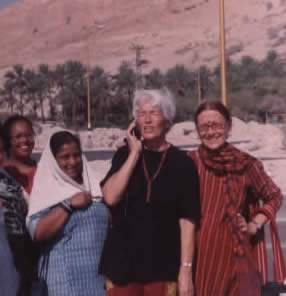 |
1999 in Ein-Gedi: Nalini is seen to the left, while I
stand with lphone next to Gabriele to the right
I now found a clearer photo of Nalini
Nayak
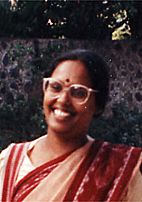 Nalini then brought
me a precious cloth from Africa.In my flat in Arad it
became a curtain, which I have in front of my eyes every
day.
Nalini then brought
me a precious cloth from Africa.In my flat in Arad it
became a curtain, which I have in front of my eyes every
day.
|
There was a whole turn towards feminism in the Fish Workers’
movement at the time in which I got involved over the years.
Likewise, since late seventies Construction
Workers Movement had been built up in Chennai by R. Geeta and
Subbu. Pennurimai Iyakkam, with which I got involved since 1979,
was founded side by side with the union work. So there has always
been a very close connection between union work in the informal
sector, women’s issues and slum dwellers issues. There
has been a clear class perspective and also a good understanding
of caste and cultural issues.
At the same time I have to say that I have also been indebted
to the so-called autonomous women’s movement. I was involved
in the autonomous
women’s conferences in the eighties and also was closely
related with the Indian
Association of Women’s Studies (IAWS) since 1983.
I have served on the Executive several times and have organized
regional conferences during the nineties. This has been a very
enriching experience in terms of analysis and getting a grasp
of the women’s movement at the national level. The IAWS
has had a very activist ethos and has been quite radical, especially
in its stand against communalism and war.
How have these involvements changed your
life?
GD Very, very much I think. I
sometimes find it a bit hard to catch up with myself.
It started off innocently enough with growing my hair and getting
myself into sarees. There was this traumatic experience
on a country road way back in 1972, when a passenger picked
a fierce argument with a conductor in a bus because the conductor
had made me to get up from a ladies seat, thinking I was a man
looking at my jeans and short hair and lack of ornaments. But
the passenger had heard my voice. I didn’t mind at all
getting up for the women with children, but it became a prestige
matter between the conductor and the passenger and the driver
stopped the bus until the matter was resolved. The traveling
public took immense interest. It was extremely embarrassing
and I concluded that my exterior had to change because it was
unpractical. I did not immediately realize that what
is inside is outside and vice versa. Bangalore was very cosmopolitan
and it was a matter of adjusting to rural situations on occasions.
This changed drastically in Madurai with three thousand years
of Tamil culture on top of myself. Even Salwar
sets were unheard of at the time. Besides, there were
years of struggle to come to terms with the language.
Most of the time when I asked “how
does one say this in Tamil”, someone would say:
“We don’t say this in Tamil”.
So I spent hundreds of hours speechless, but listening with
concentration and noting down words. I also took umpteen classes
and many friends have helped me with translations for years,
for which I am very thankful. As I learned most of the colloquial
language from slum dwellers, I often felt my whole brain
had to change. On the other hand, there was the much
more formal language in the college, most harrowing of all the
chapel language, which I found most tedious to acquire. Building
up teaching in Tamil was very difficult. The children spoke
Tamil to each other and we had English as a link language. Though
I still read German fluently if necessary and also understand
it quite well, except some of the new words and idioms which
have come up over the past 32 years, I have lost the familiarity
of expressing myself in that language. It does not come naturally.
I also find it very difficult to follow certain arguments because
many things seem to have hanged culturally, of which I do not
have a feel.
I have traveled very widely at the national level and have
studied Hindi repeatedly. But I have never stayed in North long
enough to become familiar, I have this typical Tamil mental
block against Hindi imposition, even though I would love to
be able to overcome that. But through the movements I have had
many friends in many parts of the country and have moved with
them and stayed in their houses. I have felt at home in many
places, despite the language difficulty. My friends in other
parts take me with a sense of humour: “She
can’t help it, she is a Tamilian”.
I think I have been very privileged that through so
much work in different parts I have been able to develop a love
of the country which is like a mosaic consisting of many cherished
pieces. There are two things, which I find most important. One
thing is the movements were our kinship system, our extended
family. Our children have grown up with this feeling of all
these uncles and aunties on the road and sometimes in jail.
Secondly, I have always ultimately felt answerable to the workers
in the unorganized sector, the Dalits, the Adivasis. So I do
find it very revolting how the politics of the rich and privileged
is violating the right to life and livelihood of the vast mass
of people. It pains me that often the churches adhere so much
to a middle class ethos that they seem to forget that we can’t
serve God and Mammon at the same time and that the good news
is really meant to be for the poor.
Why did you become an Indian citizen?
GD It first struck me in the early eighties when I got involved
in the IAWS. It was such a vibrant movement at the time with
a very strong caucus of grass roots activists. I wanted to belong.
I also always felt if I involved in struggles, it would affect
my visa. It’s o.k. to be arrested, but being deported
is a different matter. In my application I wrote that
I felt I belonged and could not think of living anywhere else,
and that was the truth. I got a lot of support from Veena Mazumdar
who was the Secretary and President of IAWS at different occasions
and C.P.
Sujaya, a feminist bureaucrat who knew our movement and
had read my articles.
How do you look at your national identity
and how do you feel accepted as an Indian?
GD I had never felt as “being German” because I
felt I was only from that special political unit of West Berlin.
At no point in my life had I felt I had a country. It was all
in pieces when I grew up. When coming to India, I had a Dutch
passport through marriage because it was easier to cross borders
in Germany with it, but I had never lived in the Netherlands
either. Later I found that I had lost German citizenship some
time in between without noticing, because living in a third
country, I had not made use of it. So I finally renounced the
Dutch citizenship as well when I became an Indian. The
only German identity which has stayed with me is the collective
historical responsibility for the holocaust and all that followed
from it, including the extremely tragic situation of the Palestinian
people. This history is also helpful to understand many of the
contemporary events in South Asia, including the Tamil
Sinhala conflict in Sri Lanka and the rise of communalism
and fundamentalism under globalisation.
Regarding the acceptance, it is difficult to say. With people
who know me well, acceptance has often been very wholehearted
and even overwhelming. But people who do not know me, have their
own stereotypes and projections. I find things are becoming
more difficult because of globalisation. The growth of tourism
creates different types of images. The Sonia
Gandhi’s syndrome is also very tiresome. Of course
my history is exactly the opposite, as I got citizenship despite
being married to a foreigner. This is a very great achievement
of which I am proud. She got hers as daughter-in-law and wife
of different prime ministers. So it’s really nothing to
do with me. But I can’t also get worked up if some people
(especially in the church) start projecting such things on me,
because I can sympathize with the anti-colonial thrust of such
sentiments, even if they appear misplaced.
As my friend Nandita
Haksar used to say: “Race is a
reality, we have to live with it”. She is a Kashmiri
Pandit married
to a Tankul Naga. When traveling, she has sometimes been mistaken
as an American married to a Japanese. So we have a good laugh
at it and carry on with out lives. My children when in school,
have at different junctures, been mistaken as suffering from
alibinism. When I applied for citizenship, C.T.
Kurien, who gave one of my affidavits, said that someone
in the administration had asked him how I thought to be an Indian
without having a caste. This question really troubled him. As
I had lived with Dalits closely from early on and had great
respect for Dr.
Ambedkar, I said: At least abolition
of caste can’t be a problem for me, and I have never been
able to rely on any kinship system anyway.
I feel many people are so pre-occupied with the duties of the
lifecycle and the politics of their kinship systems that they
do not fully appreciate the very strong networks of support
structures which have come into being through social movements.
It is entirely by being part of this that I have felt to be
an Indian and have also felt very much accepted as one. It
is a matter of location. Had I migrated to the US like Elisabeth
Schussler Fiorenza, I would certainly like her never have
wanted to become a citizen there. Becoming an Indian is a very
different matter. I have a strong affinity with the history
of the freedom struggle and the
Adivasi and Dalit movements, also the history of the Dravidian
movement in as far as it was serious about social transformation.
[Here on I became
tired of finding and adding links]
Can you tell something about your involvement
with Dalit and Adivasi
causes?
GD I gravitated towards Dalit struggles quite intuitively right
from the beginning, even though they still called themselves
Harijans at the time. I had decided that a study on Religion
and Development in which I was involved in CISRS could only
be based on people’s organizations and struggle. This
is how I organized my research on Religion and people’s
organization around the struggles of landless agricultural labourers
in the Cavery Delta. As I said, I came to know Mr. S. Jaganathan
and his wife Krishnammal, who is herself a Dalit. Both had worked
in the Kilvenmani area after 44 people had been burnt in a hut.
I also moved with people from CPI-M and CPI who had also organized
the labourers.
We stayed in the cheris and took bath with the water buffaloes
and had great difficulties to get good drinking water. We even
got separate tea glasses in the teashop. I came out
of it with typhoid, two types of worms and chronic amoebiasis.
This, in fact, was the outcome of untouchability, though I could
not understand it very well at that time. Other than this, I
have always had a great affinity with the life stories of Dalits,
because my own early childhood had been marked by hunger, scarcities
and violence and struggle to cope with education. Nothing could
be taken for granted. So I have always felt close to Dalits,
while at the same time being acutely aware that they would not
spontaneously feel close to me, because to them I look like
a Brahmin, white and tall and educated. So I have always worked
with Dalits in class organizations and women’s organization,
but have never attempted to get access to their own movements
in more direct ways. We did support from the outside
frequently, especially when there was widespread violence, e.g.
when there was rampant election violence in Cuddalore in over
50 villages in September 1999, the Women’s Struggle Committee
had a dharna in front of the Cuddalore Collector’s office
while Dalit organizations were still refused permission for
any manifestation. In our mixed organizations we have made education
on untouchability among non-Dalits a point and the people in
our movements stay in anyone’s houses and eat anyone’s
food. But of course it is a very long process and not easy.
I have always felt that organization building of workers in
the informal sector is very important for Dalits because that’s
where their livelihood is. I have given this priority over advocacy
to protect from violence, though we have always been ready to
intervene when violence erupts. I also feel that the struggle
against globalisation is very important for Dalits, as this
is again the field where their livelihood is affected.
Regarding Adivasis, my understanding of their life is most
indebted to the Narmada Bachao Andolan (NBA).
We first got strongly aware of the NBA when it had succeeded
to throw out the World Bank (WB) from funding Sardar Sarovar
Dam Project in 1993. It was a time when the WB was evicting
slum dwellers in Madurai in the name of canal cleaning. The
fact that the Adivasis had thrown out the WB from SSP inspired
us very greatly. It created a spontaneous bond. I met Medha
Patkar in Delhi at the time in a meeting against the
World Bank and we have been supporting the NBA ever since through
protest letters solidarity visits, writing, exhibitions. My
daughter has been a full-timer with NBA and other movements
for years. I have also been in touch earlier with friends
who worked with Adivasis in Singhbhum and for many years we
visited regularly the Chhattisgarh Mukti Morcha (CMM) from which
we have learned a lot. The Marxist Coordination Committee (CMM)
of Comrade A.K. Roy also is close to our unions, so Jharkhand
is always on our minds.
I feel the Dalit and Adivasi struggles are most crucial in
times of globalisation to protest the dominant development paradigm
and to remind us that we have to really build a very different
mode of production in which subsistence production is taken
seriously and will not be wiped out. It is a matter of building
alliances among the internal colonies. I have also worked a
lot over recent years visiting different states in the North
East and trying to understand how forest and agriculture can
be made more viable. We have held workshops with activists and
villagers to help with assessment of resources and skills and
with building alternatives. We have had many students from those
states at the PG level, and they really appreciate if we take
the trouble to learn from their life world and help them to
understand transformation. We have also taken people from the
North East to Narmada and vice versa as part of alliance building.
Of course there are enormous differences in lifestyle, education
and religious background. But slowly a better understanding
can grow.
What is your response to communalism, Ayodhya
and conversion debate?
GD From my background you may be able to understand that I
have always had quite an aversion to mission, because I was
acutely aware how much it has been historically connected with
conquest, colonialism and imperialism. This was particularly
true for the conquest of South America. Of course, I am not
making this as a general statement. I am aware that some of
the missionaries in India were critical of the colonial powers,
but even they were often not very respectful of indigenous cultures.
So I do find that the attempt to make converts is always deeply
problematic. There has been a lot of cultural imperialism in
mission. At the same time, I am a strong believer in the freedom
of religion. I feel the constitutional right to profess and
even propagate one’s religion is very important. If people
wish to change their religion, nothing should stand in their
way. It is a fact that in India, Dalits and Adivasis and sometimes
women like Pandita Ramabhai have wanted to change their religion
because of oppressive social customs in their environment. It
is therefore objectionable if laws are made, like recently in
Tamilnadu, which construe the desire for social emancipation
to be “inducement”. Of course I am deeply critical
of any attempt to push people to change their religion, be it
by spiritual or material promises or by instilling fear. But
I feel that some of the anti-conversion laws can anytime be
misused against social activists and minorities. At the same
time, these laws will never be used to curtail trishul dikshas
among Adivasis. The whole conversion debate has enhanced hatred
and suspicion among different communities. When Graham Staines
and his two sons were murdered, there was this debate whether
he had tried to convert anybody, as if that would make it legitimate
to roast little children alive. I feel freedom of religion is
a humanist value which should be held in common by all communities
and people without religious faith.
Regarding rising communalism, it is indeed
a menace, which has grown in leaps and bounds after Rajiv Gandhi
had compromised and allowed the locks of the mosque to be opened.
The destruction of the mosque was a looming threat for years.
I remember, how many of us had expected it to happen in November
1989. Instead, it was the Berlin Wall which was brought down
at the time. There is a link between the spread of imperialist
globalisation and the rise of religious chauvinism. This
has become very visible in the events of September 11th 2002
in the attack on the world Trade Centre. It is impossible to
give an analysis of the Ayodhya problem in an interview. I have
written on it in different places. The situation has become
much worse after the Godhra incident and the carnage in Gujarat,
which followed it. What has happened in Gujarat defies our imagination,
and the re-election of Narendra Modi in December 2002 has been
a very alarming event.
On the other hand, I am very deeply convinced that the people
of Ayodhya themselves want peace, as the constant tension affects
the flow of pilgrims, which is their livelihood. Many of the
temples in Ayodhya have been built on voluntarily donated Muslim
lands, and many of the Muslim artisans have been traditionally
involved in temple construction. The artificially built up confrontation
is quite unnatural to the history of the place. When the Desh
Bachao, Desh Banao Abhiyan of NAPM ended in Ayodhya on 30th
march 2003, we could see with our own eyes that the people of
Ayodhya wanted to build peace. It is mostly vested interest
from the outside which prevent this. At the same time, I also
feel that there is a rising movement of secularists and humanist
members of different religions which have a strong commitment
to protect the pluralistic and often syncretistic culture of
our country. There have been many attempts to attack the Baba
Budhangiri shrine near Chickmagalur in Karnataka and to convert
it into the Ayodhya of the South. But Muslims, Hindus, secularists,
social movements, intellectuals and artists have come together
in the tens of thousands to prevent vandalism and religious
chauvinism. The recent rally on December 28th 2003 was a powerful
manifestation after severe state repression in the beginning
of that month. This makes one very hopeful that all is not lost
and that chauvinism is not the last word. But I often feel,
in the churches, people do not take note of such important events
and only think that they are victims of religious repression.
How do you look at the new alliances among
people’s movements like NAPM and the WSF process?
GD NAPM has been very active against globalisation
and communalism/fundamentalism since over a decade. Many of
the member movements have been working since two or three decades.
Again, it is something on which many articles have been written.
The Desh Bachao Desh Banao Abhiyan from Plachimada – that
is the anti-Coca Cola struggle near Palakkadu in Kerala –
to Ayodhya, which stands for the desire for religious and cultural
pluralism, went on from republic Day 2003 to 30th of March and
covered about 70 districts in 18 states. This was a major attempt
to pull different forces together. I took part in Kerala, Tamilnadu,
parts of Karnataka, Guwahati, Gujarat, Rajasthan, Delhi, Lucknow
and Ayodhya. It was a very positive experience, as it made so
many local struggles visible, like the struggle against the
privatization of Shivnath river or the valiant resistance of
the fisher people against selling the island of Jambudweep to
SAHARA company. But of course, all of this is still only campaigning.
It has not yet taken off as a new freedom struggle to really
quit WTO and build alternatives.
I feel the real transformation has to happen through all the
local organization building, the changes in people’s
lives, which come out of this work. This is very arduous.
But it is happening steadily and persistently. The good
thing about NAPM is that so many different organizations are
coming together and an attempt is made to let different streams
of socialism, Marxism, Ambedkarism and Gandhism dialogue with
each other and to come to better mutual understanding of each
other and get a better grasp of the reality in which we live.
As far as WSF is concerned, I think
it has an important history, regarding the struggles in Chiapas
in Southern Mexico and the struggles of the workers party in
Brazil. Also, it is certainly important to project a Social
Forum vis-à-vis the hegemony of the World Economic Forum
which meets in Davos. This attempt itself questions the hegemony
of the global market over our lives. It is indeed a gigantic
effort to bring this about. But of course it also requires enormous
fund raising and coordination and it becomes like a big melah,
without much focus. This is why NAPM was not part of the organizing
committee, because the members were giving priority to the organizational
activities in their own movements. It was confusing that many
of our friends and members were in the Mumbai Resistance, while
at the same time these two ventures across the road were not
really able to see eye to eye. Many of us moved around on both
sides. I think many of the forces who were separated by the
big highway in Mumbai, came together in the struggle around
Baba Budhangiri in Karnataka end of December. I feel the struggles
have greater potential to unite people than the conferences.
But ventilating different opinions is also important.
Looking back on your life so far, what is
it that depresses you and what is it that fills you with a sense
of satisfaction? What do you hope for?
GD I think the difficult thing with
getting older is that the work steadily expands, while the energy
levels meet with more limitations. The sense of urgency clashes
with the need to slow down. The capacity to pick up new languages
goes down.
I also find it difficult to see globalisation
push a development model, which is so totally unviable in a
country like ours. It is amply known that what has happened
in the so-called developed countries has caused global warming
and trying to achieve all these cars and gadgets here, would
be totally unpractical. But the middle classes ignore all these
realities, and so we get these centralized projects like linking
of highways, of power grids and even of rivers. This is really
disturbing, as it can contribute to war.
At the personal level I sometimes get depressed
when I see how people get settled in life and narrow down their
aspirations for transformation and alternative lifestyles in
the battle to make a career and educate their children. They
may still retain a radical language, but it loses meaning. Globalisation
deepens this problem.
On the other hand, it is very heartening to
have had such a large number of friendships and to see the persistence
of many old battle horses. I also feel that some people in the
younger generation, my own children and some of their friends
included, are much more practically creative in the constructive
work field than many of us have been. This is one thing which
makes me very hopeful. I feel despite all this global onslaught,
I can also see a lot of sanity and determination to live differently
growing. I see a lot of courage and determination, and the sense
of vulnerability is a bit less than in my post-war experience.
I often feel that so-called achievements mean very
little, as life has to be lived each moment afresh. But I am
immensely thankful for all the friendships which have sustained
me, and often I have also discovered that I have sustained people
far away whom I did not even know. What do I hope for?
I really ardently hope and pray that we should find ways of
preventing war and controlling violence at every level. This
includes the sustenance of soil, water and forest in the hands
of local communities and the right to work. One can also call
it sustenance of God’s good creation, the beauty and variety
of it. At the personal level I would hope to be able
to live life fully and gracefully as long as it is given to
me.
From:
Yes,
creator God, transform the earth!
The earth as God's body in an age of environmental violence
Ecumenical Review, The, April, 2005 by Aruna Gnanadason
... Gabriele Dietrich, a theologian
in India, reflects on the earth as the body of God from
the perspective of fisher-women and urban poor women in India.
For her what is of crucial importance in an ecological theology
is the "sustaining power of women who keep life going by
the labour of their wombs and of their hands". ....
Gabriele on May 23: "The thing you
did not find was Sozialistischer Frauenbund. I had translated
this name into English, because the German cannot be understood."
|
Gabriele Dietrich
The Socio-Economic and Political Relevance
of the Eucharist
presented at a Seminar in the TTS ,
Introduction
The socio-economic and political significance of the Eucharist
in the present situation of globalization is of enormous critical
significance, but in order to understand it, we have to go into
the history of liberation theology in Latin America and Asia.
We also have to understand the Feminist as well as the Dalit
critique of a class reductionist interpretation of exploitation
and the theologizing on the body as a
symbol of human suffering and the need for redemption.
In this context, a Feminist or womanist interpretation is also
of great relevance, but it needs to be connected with an ecological
thrust. The overall context in the present situation is that
of contestation for food security and land and the need to overcome
violence. I am starting to write this paper on the day when
Tata inaugurates
the “people’s car” at the rate of Rupees One
Lakh at Pragati Maidan in Delhi 10th January 2008. We all know
that this kind of policy is related to the violent confrontation
over agricultural land in Singur in West Bengal where the Tata
factory is being built and in Nandigram, where people have fought
relentlessly against the government acquiring land for a chemical
hub. People have been shot by the coercive forces of the Left
front Government by the dozen, and the numbers of disappeared
and of women raped in the cowsheds is very high.
We are also recalling the critical situation in Chhattisgarh,
the State of the slain trade union leader Shankar
Guha Niyogi, whose murderers are known, but have been left
scot free by the highest court of the land. The State is now
ruled by the BJP and
human rights activist Binayak Sen sits in jail since the
14th of May’07 for no other fault than meticulously documenting
the state policy of Salwar Judum, which has led to a civil war
on the tribal population in interior districts like Dantewada1.
In this war on people, very young tribal women (14-18yrs old)
have been recruited into the police force by the State and have
been physically abused without respite.
Some Reminiscences in a Social Analysis
Perspective
There are certain memories, which need to be revived regarding
our ways of looking at the Eucharist in TTS. The book by Timothy
Gorringe on the Eucharist [she
may refer to his book: "The Education of Desire: Towards
a Theology of the Senses" , 2001, or to "Harvest:
Food, Farming and the Churches ,2006 ] has certainly
been a mile stone. His thrust is to connect
the Eucharist with the memory of the feeding miracles of Jesus
and with the emphasis on food sharing in the desert.
He critiques the church mystifications which alienate the Eucharist
from a real life situation and fix it in doctrinal schemes of
sin and redemption. In the reformation tradition, the critique
of trans-substantiation, a doctrine upheld by the Catholic Church
is important. Trans-substantiation had led to a magical understanding
of the Eucharist. The term “Hocus
pocus”, used for magical deception, derives directly from
the Latin rendering of the words of consecration: “Hoc
est enim corpus meus” (This is my body). However,
this has led only to new protestant mystifications, which tend
to over-spiritualise the experience of the Eucharist and to
co-opt it into a highly personalized
interpretation of individual sin and redemption. This
takes the focus away from what Dr. M.M.
Thomas has expressed in the term “structural
sin”. Thus, we have to keep in mind that sin and
redemption are also corporate experiences, which have intrinsically
links with struggle for social transformation.
Further, as far as TTS memories go, we have to keep in mind
the history of Social Analysis and of Latin American and Asian
Liberation struggles. One of the most significant experiences
has been the life history of Camillo
Torres, the Columbian Priest who had studied Social Analysis
under Francois
Houtart in Louvain in Belgium during sixties. At his return
to his country, he not only established Social Analysis research,
he ultimately decided to join the guerilla movement, because
he felt he could not go on celebrating the Eucharist as long
as people were not fed in his country and the gap between rich
and poor remained unredeemed. He lost his life in the struggle,
but is well remembered, similar to Che’Guevara,
a revolutionary from Argentina who had joined the Cuban
revolution in 1959 and who was later killed in Bolivia.
It was this revolutionary history, which led Fidel
Castro, who was a Marxist Atheist, to seriously look into
the revolutionary left Christian Traditions and to take this
history seriously3. In TTS, it was the visit of Enrique
Dussel in 1992 which reminded us that this kind of critique
goes back to Bartolomeo
de las Casas, who was one of the catholic clergy, who took
to a radically anti-colonial interpretation of the Eucharist
early on in the colonial history4.
This anti-colonial history has been revived again and again
in other Latin American countries. E.g. it is at the root of
the struggles of the Churches in Brazil, where the Bishop of
Recife Helder
Dom Camara5, took a determined stand with the poor in the
impoverished Northern parts of the country. The same history
was re-inacted in the struggle in El Salvador, where Archbishop
Romero was murdered during celebration of the Eucharist
for his valiant stand against the military junta. It was Romero
who had taken a very radical stand after the murder of democratically
elected President
of Salvador Allende on the first
9/11 in human history, i.e., the bombing of the Almeida
(Presidential palace) by the CIA in Santiago
the Chile, in 1973. This led to fascism in Chile under Pinochet
for decades and to the death of thousands of people over the
decades. The Dutch camera team of Koos
Koster and his three associates, who were shot in El
Salvador in an ambush while documenting the uprisings in
the jungle against dictatorship, way back in 1983, were commemorated
in the TTS chapel as a radical witness to the true meaning of
the Eucharist. The text which inspired Bartolomeo de las Casas
to his radical anti-colonial critique is written in Jesus
Sirach Chapter 34, vs. 21-31 –
Offering Sacrifices
If one sacrifices ill-gotten goods, the offering
is blemished; the gifts of the lawless are not acceptable.
The Most High is not pleased with the offerings
of the ungodly, nor for a multitude of sacrifices does he forgive
sins.
Like one who kills a son before his father’s eyes is the
person who offers a sacrifice from the property of the poor.
The bread of the needy is the life of the poor; whoever deprives
them of it is a murderer.
To take away a neighbor’s living is to commit murder;
To deprive an employee of wages is to shed blood.
When one builds and another tears down, what do they gain but
hard work?
When one prays and another curses, to whose voice will the Lord
listen?
If one washes after touching a corpse, and touches it again,
what has been gained by washing?
So if one fasts for his sins and goes again and does the same
things, who will listen to his prayer? And what has he gained
by humbling himself?
It is the memory of people like Bartolomeo de las Casas, which
has also fed into the tribal uprising in Chiapas,
on the Southern border of Mexico6. These tribal uprisings in
turn have led into the worldwide attempt to critique the World
Economic Forum and to bring about the World
Social Forum. Very sadly, even such attempts at a worldwide
critique on globalization have been co opted in our country
by the communist parties and the NGO sector, the same forces
who today take a stand that capitalism is there to stay and
we have to go along with it. It is therefore; amply clear, that
we need to renew a radical interpretation of the Eucharist,
if we want to do justice to the radical option, which Jesus
took in his own life. We therefore, need to turn to sources,
which help us to deepen our understanding of the Eucharist.
Feminist Interpretations
Feminist interpretations are of great relevance here, though
they have not become part and parcel of the TTS heritage to
the same extent as the class-related positions which were outlined
above. This has to do with the fact that “the big TTS
family” over the past thirty years has not really succeeded
to incorporate women in their
own rights. I am not saying “as equals”, because
the very term of “equality” much of the time pre-supposes
men as the point of reference. The point is not “being
equal with men” – the point is that men are of incomplete
humanity as long as violence rules the world. The
aspiration for “equality” has led to the incorporation
of women into the capitalist world system under highly disadvantaged
conditions. It is the World Bank and the corporations, who have
incorporated feminist conceptualizations and who have also succeeded
to obscure the reality of patriarchy under the smoke screen
of an elaborate rhetoric of “gender”. In the churches,
we find a culture which is steeped in middle class consumerist
modernity of neo-liberal capitalism, while
at the same time the feudal values of caste, hierarchy and an
oppressive family ideology are also alive and well. It
is therefore important to widen our perceptions beyond an
all-male Trinity of Father, Son and (supposedly male) Holy Spirit
and to understand that incarnation cannot
be conceptualized without taking on board women’s bodies,
abused, bleeding, polluting, sexually active, life giving, nurturing,
and widely advertised, venerated in motherhood as well as feared,
glorious as well as wretched. This
female reality is normally banned from the Eucharist when it
comes to understanding “the body”.
It was the reality of child bearing and child rearing in TTS
while being a full time faculty member, which triggered my anger,
my despair as well as my rebellion to cope with the patronizing
attitudes I encountered all over the place. One of the outcomes
of this experience was a poem, which has made it into various
theological publications7. As the poetry is self-explanatory,
I am rendering the poem in full.
The Blood of a Woman Hiroshima Day
August 1984
I am a woman
and my blood
cries out:
Who are you
to deny life
to the life givers?
Each one of you
has come from the womb
but none of you
can bear woman
when she is strong
and joyful and competent
You want our tears
to clamour for protection.
Who are you
to protect us
from yourselves?
I am a woman
and my monthly bloodshed
makes me aware
that blood
is meant for life.
It is you
who have invented
those lethal machines
spreading death:
Three kilotonnes of explosives
for every human being
on earth.
I am a woman
and the blood
of my abortions
is crying out
I had to kill
my child
because of you
who deny work to me
so that I cannot feed it.
I had to kill my child
because I am unmarried
and you would harass me
to death
if I defy
your norms.
I am a woman
and the blood
of being raped
is crying out.
This is how you keep
your power intact,
how you make me tremble
when I go out at night.
This is how you keep
me in place
in my house where
you rape me again,
I am not taking this
any longer.
I am a woman
and the blood
of my operations
is crying out.
Even if I am a nun
you still use my body
to make money
by giving me historectomy
when I don’t need it.
My body is in the clutches
of husbands, policemen,
doctors, pimps,
there is not end
to my alienation.
I am a woman
and the blood
of my struggles
is crying out.
Yes, my comrades,
you want us
in the forefront
because you have learnt
you cannot do without us.
You need us
in the class struggle
as you need us
in bed
and to cook
your grub
to bear
your children
to dress
your wounds.
You will celebrate
women’s day
garlands
for our great supporters.
Where would we be
without our women?
I am a woman
and the blood
of my sacrifices
cries out to the sky
which you call heaven.
I am sick of you priests
who have never bled
and yet say:
This is my body
given up for you
and my blood
shed for you
drink it.
Whose blood
has been shed
for life
since eternity?
I am sick of you priests
who rule the garbagriha
literally
'womb-house', the central part of a temple where the main deity
is enshrined ,
who adore the womb
as a source of life
and keep me shut out
because my blood
is polluting.
I am a woman
and I keep bleeding
from my womb
but also from my heart
because it is difficult
to learn to hate
and it might not help
if I hate you.
I still love
my little son
who bullies his sister
he has learnt it outside,
how do I stop him?
I still love
My children’s father
because he was there
when I gave birth.
I still long
for my lovers touch
to break the spell
of perversion
which has grown
like a wall
between women and men.
I still love
my comrades in arms
because they care
for others who suffer
and there is hope
that they give their bodies
in the struggle for life
and not just for power.
But I have learned
to love my sisters.
We have learned
to love one another.
We have learned
even to respect
ourselves.
I am a woman
and my blood
cries out.
We are millions
and strong together.
You better hear us
or you may be doomed.
[see
Gabriele's poem at the entry to my website!]
I think it is self evident that the understanding of a
woman’s physicalness and the spirituality arising out
of this physical existence needs to inform our understanding
of “full humanity”. I have dealt with this
extensively in other contexts8. It has been recognized widely
that such enhanced theologizing on the incarnation has Christological
significance.
Over recent years, Dalit women’s theologizing on poverty,
land, women’s bodies has found a voice. A good overview
over the complexities of Dalit feminist/womanist positions can
be found in a special issue of In
God’s Image, which was guest-edited by Monica
Melanchton9. While
many of the articles focus on the rampant atrocities committed
on Dalit women
as “triple oppressed”, there is also clear reflection
on the “duality of patriarchies”, i.e. not only
the upper caste patriarchy, but also the internal patriarchy
within Dalit communities. Likewise, while the specificities
of Dalit women’s experiences are fully acknowledged, the
commonalities with women’s experiences of purity and pollution
and day to day violence are also integrated10. Apart from this,
several of the articles point beyond the immediate experiences
of grinding work and physical violence and open up perspectives
of not only protest, but social transformation, based on connection
with the land, a culture of transgression and transcendence
and a vision of healing in the spirit of Mary
of Magdala11. Obviously, the Eucharist in this day and age
can only have full meaning if it commemorates and expresses
such crucial experiences. The question is how this can be done
effectively and creatively.
The Challenges and Burdens of “Community”:
It is in the nature of the Eucharist that it is trying to
create community, overcome barriers and to make the vision of
the “Reign of God” or the “Kingship of God”
visible. “Kingdom values” is certainly not a fortunate
term, as it warms up a feudal political form, giving it eschatological
sanction. We are told by Jesus that we cannot serve God and
Mammon (Mk. 10,17 – 31) and that the new community will
be one without fathers. [where
is this written?] The Eucharist needs to express this
vision.
It is unavoidable that in a caste ridden society, the history
of the Church has also followed the cultural expressions of
different communities, usually more high church for upper castes
and more Lutheran for Dalits. The cultural expressions were
anyway borrowed from the missionaries and an indigenous idiom
was slow to form. Parattai,
in his grama isai vazhipadu, has used the rhythm and the idiom
of rural Dalit communities to express the social alienation
and the need for redemption and healing. He has clearly expressed
the life world of Dalits, in which sin is not of an individualistic
nature, but has to be understood as “structural
sin”, where people are either coerced to participate in
their own oppression or try to resist in anger and despair.
There has been debate whether addressing God as “swamy”
re-inforces sub-altern cultural patterns. But there is no doubt
that the Eucharist in this rural context is deeply tied up with
the earth, with nature, with food security and the desire to
share food beyond all the barriers of purity and pollution.
This is an endeavour which is deeply life-affirming.
In an attempt to strengthen this life affirming tendency, not
only the words of blessing for the Eucharist have been adjusted
to the cultural setting, but also the elements. Bread and wine
being very much part of the Palestinian cultural space and having
been flattened into wafers and grape juice in a ritual setting,
are limited in the meaning they can transport. So variations
have included kanji, karuvadu (dried fish), chukkukapi, keppai
rotti and many more. If this happens, controversy arises about
how much these elements can “represent the body of Christ”,
are they not too crude? Since the body of Christ consists now
of the people of God, those who do his will, it is only natural
that it can be represented by the food which people are willing
to share. This willingness is tested by cultural constraints.
If people have been brought up in a ritualistic environment
and with strong doctrinal notions, this will be causing consternation
in unexpected situations.
While in Parattai’s liturgy a certain doctrinal decorum
is observed, I have frequently substituted the part of the blessing
of the elements with a blessing from Sri Lanka, which comes
directly out of the context of the feeding miracle.
Five loves and two fishes in the hand of the child
He gave them to Jesus happily
He (Jesus) blessed, broke and gave them
He made the hunger of 5000 people to go.
This blessing existed in Sinhala as well as in Tamil and was
very meaningful in the situation of the strife ridden ethnic
conflict. The meaning of sharing all we have is immediately
called up. The memory of the boy with the fishes also stands
for the fishing community of the Lake of Galilee. There was
no blessing over the wine though, to correspond to this. We
therefore created a wording, which connects the blood of Jesus
with the blood of women.
The blood of Jesus and the blood of women
shed together
tells us to work for the life of the world
after blessing, having given to drink,
He asked us to live as disciples.
This has led to a lot of speculation, what the connotation of
“the blood of women” may be and whether this blood
is equated with the blood of Jesus. Some of my colleagues have
walked out over this blessing.
However, the underlying important observation is that the world
is full of violent bloodshed. In the caste hierarchy, the kshatriyas,
who are professionally recognized as a warrior’s caste
shedding blood, are not polluted or polluting. There is no stigma
attached to their profession. Likewise, among tribals in North
East India, the warfare of the men for protection of
villages and conquest of new territory is heroic and meritorious,
while women’s work in agriculture is rendered much less
visible and is considered insignificant. In the mainland,
women are routinely seen as polluting and polluted due to the
very life-processes of menstruation and child bearing. Not only
that, women endure violence in the family for the sake of protecting
their children and for upholding their family life. They are
also violated in communal riots and caste confrontation as a
pawn of community identity. At the same time, they can usually
not retaliate. Their effort is constantly to affirm life and
to keep it going. Only in rare cases, women take recourse to
suicide and even take their children with them.
Women’s life-blood shed for the survival of humanity and
of community is not normally understood as sacred or redemptive.
This has to a large extent to do with the fact that women are
misrepresented as the origin of sin and the wage of sin is death.
Thus, the life givers from whom we all stem are depicted as
the origin of death. This is a powerful politics, which affirms
destructive violence, but does not acknowledge suffering which
is life-affirming. The disciples were weary of the women in
Jesus’s company. They also tried to ward off the children.
The logic of purity and pollution is deeply interwoven with
artificially created boundaries, which keep women under control.
While one has to be extremely careful not to romanticize
women’s suffering or even to glorify it, it is important
to acknowledge women’s contribution to the production
of life and livelihood. It is also necessary to acknowledge
the inherent discrimination which goes with being born female.
The very decline in the juvenile sex ratio which goes on deteriorating,
witnesses to the fact that female children are undesirable and
considered a liability. The tenacious struggle against undeserved
and unwarranted suffering is in itself life-giving. This struggle
transcends class and caste, as foeticide is rampant among middle
and upper classes and castes, but spreads among Dalits as well.
Jesus’s birth amidst the murder of boy children –
designed to prevent the new King from coming into this world
– has a strange and inverted resonance in today’s
situation of girl children.
This struggle for life and dignity also has a commonality with
Dalit struggles for human dignity, be they male or female. It
is clear that Dalit women are Dalits among the Dalits. But this
does not single them out as champions of victimhood, as the
goal is the end of discrimination and the affirmation of life
and wholeness. This struggle for wholeness becomes more difficult
in a situation of displacement and destruction of natural resources.
Adivasis and peasants are massively being displaced by development
projects and SEZ’s
and Dalits, especially Dalit women, lose their livelihood as
agricultural labourers and are pressed into migration and destitution
or prostitution. Food security is more and more in jeopardy.
The bread and the wine were the most ordinary agricultural products
in Palestine. The Eucharist is a symbol
of sharing simple food without discrimination of class, caste
and sex and it includes the memory of God’s covenant with
his good creation, the memory of the exodus from slavery, during
which food became scarce and the memory of this struggle against
slavery, which is expressed in the celebration of the Passover
and the Sabbat. It is clear that such sharing presupposes a
society in which exploitation of human beings and of nature
has to be ended. In this sense, the Eucharist also reminds us
that capitalism is not a form of production and of organizing
society, which is sustainable or could implement social justice
and peace with nature. It also reminds us of basic democracy,
because it can only fulfill its meaning if every one can participate.
Let the Children Come to Me
This leads us to the final question of participation of children.
Traditionally, children have been excluded from the Eucharist,
because the assumption was that they could not comprehend the
depth of the mystery. This is of course only applicable if one
pre-supposes a very complicated doctrinal understanding of the
Eucharist. If the material socio-economic
and political connotations of the Eucharist are taken into consideration,
then the bar on children’s participation makes no sense.
Children love to share food and being excluded from it creates
a barrier, which is deeply alienating. Children also
should not be sent off with a sweet instead of bread, as this
is bad for their teeth and encourages wrong and consumerist
food habits. On the contrary, socializing children into participation
in the Eucharist can enable them to have respect for food, for
agricultural labour, for the earth and can teach them to transcend
barriers of caste, class and sexism. This however presupposes
deep changes in our Sunday school teaching, e.g. the sexist
interpretation of the creation narrative in Gen. 2 and 3, especially
the rendering of chapter three, which implies a certain amount
of justification of woman’s subordination, must be dealt
with sensitively and creatively so that woman’s life-giving
quality can be affirmed and honoured. After all, the very name
Chavah (Eve) connotes that she is “the Mother of all Living”
and not the originator of sin and death.
We also have to honour the initiative and independence of our
children. The suggestion that they should only come with their
parents is counter productive. It encourages parental supervision
and subverts the children’s sense of bonding with each
other and the feeling that they are really wanted as they are.
It makes little sense to teach children to walk and speak in
their first two years and then only to expect them to sit down
and keep quiet. Some roaming around, does no harm. They should
be able to come to chapel even if their parents are unable to
come.
Besides, it is important that the service gives everyone their
own space. In recent times, it is becoming fashionable to have
families sitting together and trouping to the Eucharist together.
In the TTS chapel this only amounts to having the right side,
which was normally reserved for women, encroached by more men.
Women’s own space shrinks, instead of being expanded.
Jesus welcomed the children, he also attracted women to roam
around as disciples. In the parable of the rich young man, who
does not want to leave his riches, he says that everything will
be given to us, but the new community
has no fathers (Mk. 10, 13-31). [Rachel:
I have the gravest objections against this interpretation and
against the NT saying itself! it is very similar to the old
claim, that both Body and Earth need to be left behind, if "Heaven"
is what we want! It is in the mutual dependency between family
members that we grow!] This can only mean ["only"?
what kind of forceful interpretation is that!] that it
should be free from patriarchy. Allowing spaces of free and
voluntary participation early on is very important. I have been
very thankful that my own children were able to grow up in such
freedom and it would be a great loss if such space were taken
away. [What has this to do with that horrid
Jesus-saying in Mk 10:29??]
Conclusion:
There is no doubt that such affirmation of Life is of enormous
importance in times of global warming, where the energy crisis
can lead into a new World War. The “new
Fordism”12 of the
Tata’s which tries to awake aspirations of individual
horizontal and upward mobility, creating competition between
fuel crops and food crops, is deeply divisive and destructive
of democracy. In Tamil Nadu, such policies are in full swing
with the car industries fully entrenched around Chennai and
SEZ’s covering thousands of acres between Chennai and
Chenglepet. It has been shown clearly that globalization has
fragmented the working classes and destroyed natural resources
and agriculture. It has also led to farmer’s suicides
and to rising violence against women. It is of great importance
that the revolutionary implications of the Eucharist are better
understood in today’s situation. This is a challenge to
our Faith and our Creativity. In a way, the Eucharist implies
an integration of economic and political human rights, which
in the history of the cold war have always been polarized against
each other. It also affirms the redemption of nature from the
ruthless exploitation of human beings. We have to move the congregations
to abandon consumerism and to see the meaning of sharing and
of democratic participation, free from casteism and sexism.
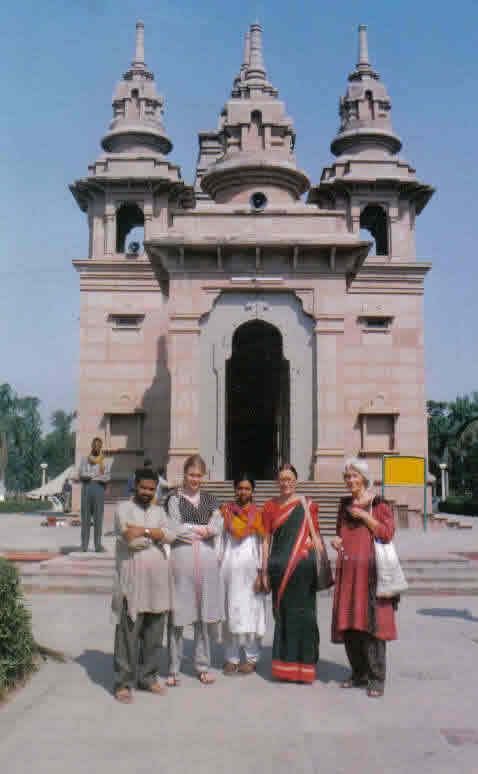
November 1998, Varanassi, North India,
from right to left:
I, Rachel, dressed in a Salwar,
next to me Gabriele in a Saree,
then Alli, the daughter of Gabriele's friend and co-worker Gita,
next to her Karuna, Gabriele's daughter.
"At that time we immersed the
ashes of Alli's Grandfather SRK in the Ganga, because he once
studied in Benares Hindu University.He was a very well known
communist"
|
